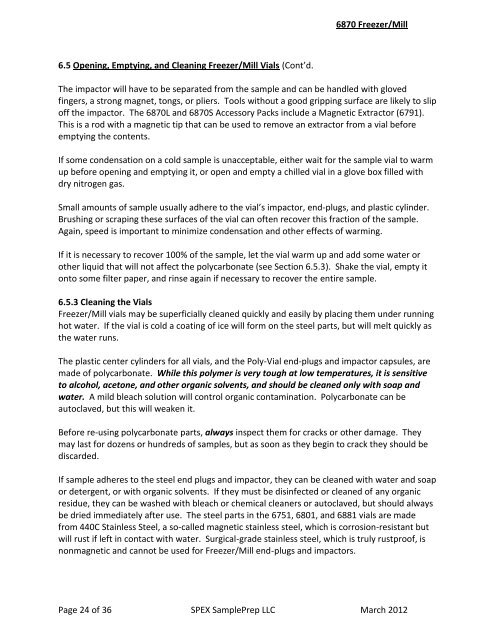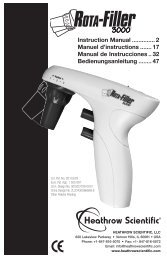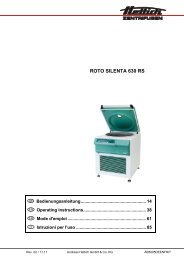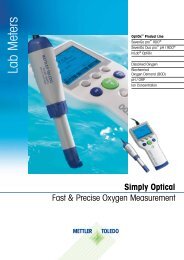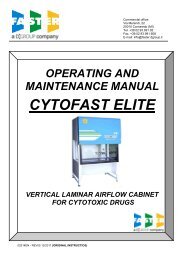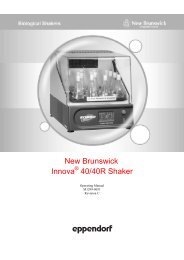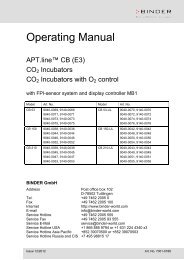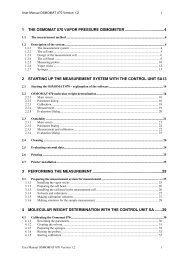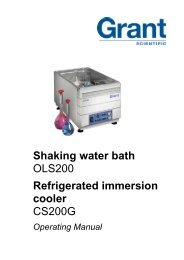#6750, FREEZER MILLS - Wolf Laboratories
#6750, FREEZER MILLS - Wolf Laboratories
#6750, FREEZER MILLS - Wolf Laboratories
Create successful ePaper yourself
Turn your PDF publications into a flip-book with our unique Google optimized e-Paper software.
6.5 Opening, Emptying, and Cleaning Freezer/Mill Vials (Cont’d.<br />
6870 Freezer/Mill<br />
The impactor will have to be separated from the sample and can be handled with gloved<br />
fingers, a strong magnet, tongs, or pliers. Tools without a good gripping surface are likely to slip<br />
off the impactor. The 6870L and 6870S Accessory Packs include a Magnetic Extractor (6791).<br />
This is a rod with a magnetic tip that can be used to remove an extractor from a vial before<br />
emptying the contents.<br />
If some condensation on a cold sample is unacceptable, either wait for the sample vial to warm<br />
up before opening and emptying it, or open and empty a chilled vial in a glove box filled with<br />
dry nitrogen gas.<br />
Small amounts of sample usually adhere to the vial’s impactor, end-plugs, and plastic cylinder.<br />
Brushing or scraping these surfaces of the vial can often recover this fraction of the sample.<br />
Again, speed is important to minimize condensation and other effects of warming.<br />
If it is necessary to recover 100% of the sample, let the vial warm up and add some water or<br />
other liquid that will not affect the polycarbonate (see Section 6.5.3). Shake the vial, empty it<br />
onto some filter paper, and rinse again if necessary to recover the entire sample.<br />
6.5.3 Cleaning the Vials<br />
Freezer/Mill vials may be superficially cleaned quickly and easily by placing them under running<br />
hot water. If the vial is cold a coating of ice will form on the steel parts, but will melt quickly as<br />
the water runs.<br />
The plastic center cylinders for all vials, and the Poly-Vial end-plugs and impactor capsules, are<br />
made of polycarbonate. While this polymer is very tough at low temperatures, it is sensitive<br />
to alcohol, acetone, and other organic solvents, and should be cleaned only with soap and<br />
water. A mild bleach solution will control organic contamination. Polycarbonate can be<br />
autoclaved, but this will weaken it.<br />
Before re-using polycarbonate parts, always inspect them for cracks or other damage. They<br />
may last for dozens or hundreds of samples, but as soon as they begin to crack they should be<br />
discarded.<br />
If sample adheres to the steel end plugs and impactor, they can be cleaned with water and soap<br />
or detergent, or with organic solvents. If they must be disinfected or cleaned of any organic<br />
residue, they can be washed with bleach or chemical cleaners or autoclaved, but should always<br />
be dried immediately after use. The steel parts in the 6751, 6801, and 6881 vials are made<br />
from 440C Stainless Steel, a so-called magnetic stainless steel, which is corrosion-resistant but<br />
will rust if left in contact with water. Surgical-grade stainless steel, which is truly rustproof, is<br />
nonmagnetic and cannot be used for Freezer/Mill end-plugs and impactors.<br />
Page 24 of 36 SPEX SamplePrep LLC March 2012


